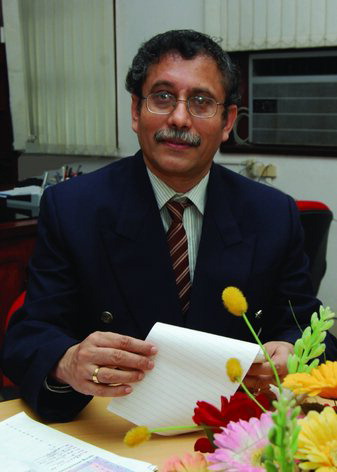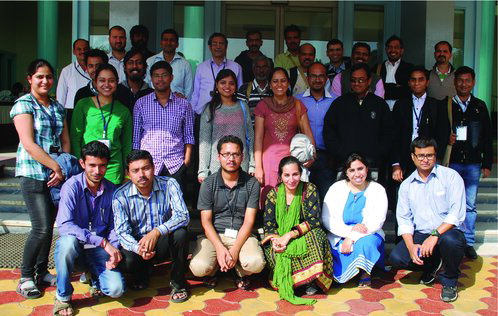Sourav Pal was born in Ranchi on 12 May 1955. He did his schooling from Ramakrishna Mission, Asansol in West Bengal. After completing school, he joined the Indian Institute of Technology (IIT), Kanpur for his integrated M.Sc. in Chemistry. For a brief period after M.Sc., he joined the Tata Institute of Fundamental Research (TIFR), Mumbai. Later he left TIFR and joined the Indian Association for the Cultivation of Science with Prof. Debashis Mukherjee for his PhD. He joined the National Chemical Laboratory (NCL) in December, 1982, immediately after submission of his PhD thesis. From 1 June this year (2015), he has joined the Chemistry Department at IIT Bombay. In his early days at NCL, he worked on the formulation of the stationary response approach for closed-shell molecules. With no computational facility at that time, he worked mainly on the formulation of the expectation value and extended coupled-cluster response approaches. This work was ahead of its time and later got recognition as an appropriate way to calculate molecular properties, in particular, for higher order properties. In the early nineties, this theory was translated into computer codes to produce the numbers. This response approach method was also extended for the calculation of magnetic properties. Recently, this approach is extended for the relativistic theory for atomic and molecular properties.
In 1986, he joined the Quantum Theory Project (QTP) with Prof. Rodney Bartlett for postdoctoral research. During his stay at QTP, he worked on Fock space multi-reference coupled-cluster (FSMRCC) theory for spectroscopic properties i.e. ionisation potential, electron affinity and excitation energy. He was instrumental for an FSMRCC code for the spectroscopic properties of molecules. Later he went to the University of Heidelberg, Germany to take up an Alexander von Humboldt fellowship from late 1987. During his stay in Heidelberg, he studied the effect of electron correlation on low-energy electron molecule scattering. His study led to the resolution of a long-standing confusion in understanding the nature of e-N2 resonances. The importance of the exchange term was realised in electron molecule scattering.
After he came back to India, he pursued FSMRCC response formulation. He made the first formulation of MRCC response theory. He published a series of papers demonstrating eventually a suitable and efficient formulation. The latter was done in Fock space as well as Hilbert space multi-reference coupled-cluster theory. This was later implemented to calculate the dipole moments and polarisabilities of excited-state molecules along with doublet radicals. His work on the response approach for both closed- and open-shell systems has received wide recognition. Recently, his group developed lower scaling approximations to EOMCC which can be used to investigate the excited states of large molecules without compromising its accuracy.
The extension of the Fock space multi-reference method for the calculation of the lifetime and decay width of resonance states was done by his group using the complex absorbing potential (CAP). This was an important development in the application of FSMRCC theory to study the lifetime of temporary-bound systems. His group also introduced CAP to equation-of-motion coupled-cluster theory which, combined with developments of low-scaling approximations, can become a major tool to study resonances as well as other decay of hole states for large systems.
During the early 1990s, he diverted his attention to qualitative theories. His work on the principle of maximum hardness attracted attention from the experts in the field. He continued working on the conceptual density functional theory, eventually being recognised as one of the leaders in the field.
In recent years, he has contributed to computational material science using the density functional theory and focused on the problem of activating nitrogen and catalysing oxidation reactions by metal clusters (mainly aluminium and gold clusters) as well as design of hydrogen storage materials.
Dr Sourav Pal has made significant contributions in diverse areas of theoretical chemistry. He is one of the few theoretical chemists in India who has worked on the demanding aspects of methodological and conceptual developments and at the same time made interesting applications to chemical problems. His works are characterised by rigour and quantitative accuracy with potential for further growth. The balance of fundamental developments along with good application has been an impressive aspect of Sourav Pal's activity. He is internationally recognised as one of the pioneers in studying in depth the role of electron correlation in molecular properties and spectra. In particular, his formulations and applications of coupled-cluster-based response approach to predict the linear and nonlinear optical properties are at the frontiers of modern theoretical chemistry. He is one of the most decorated scientists in India, who has received almost all the important awards and honours in India. He and his research group have published more than 240 papers.
Apart from his research work, he has excellent ability to encourage people and extract the best out of them. The freedom and encouragement he gives to his students allows them to excel. He is one of the best teachers that one can come across. This will be certified by most who have attended his classes of quantum chemistry at different levels from undergraduate onwards. He has been extremely passionate in teaching which he has carried out in University of Pune and Indian Institute of Science Education and Research, Pune.
As pointed out by his supervisor, Prof. Mukherjee, one of the great and unique qualities of Dr Pal is the admirable synergy of head and heart, a trait very rarely seen among the leaders in India. He has not forgotten any single person he came across earlier in his life, and he invariably behaves exactly in the same way as he behaved with the person when they met for the first time. He is a gifted speaker, always coming across as a persuasive intellectual speaking eloquently on a topic whose importance he is sure of.
During his tenure as a director of NCL, the laboratory flourished and made outstanding progress in both fundamental and industrial research. An important feature of Dr Pal is that he is always approachable to any scientist, especially younger ones, and cultivates and nurtures a positive outlook in them. His leadership resulted in excellent research work and congenial atmosphere in the laboratory which provided the right ambience in NCL during his tenure. He is also the president of CRSI and played an extremely important role to provide leadership at the national level.
This special issue is to recognise Dr Pal's contribution to theoretical/quantum chemistry. On behalf of all his students, co-workers and all those who have contributed to this special issue, we wish him many more years of productive science.
Nayana Vaval
Ajit Thakkar
G. Narahari Sastry


